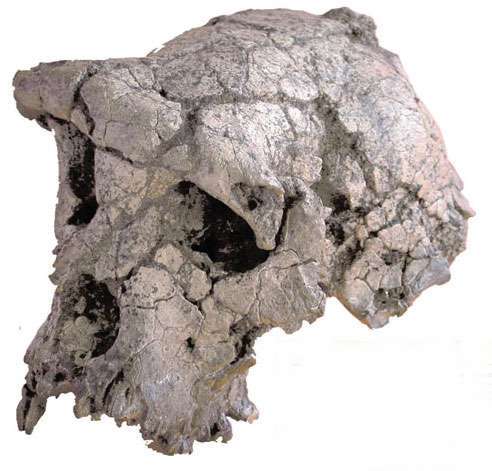As I was skimming the headlines at SciTechDaily just now, the headline CT scans of 300-million-year-old fossils provide a frightening 3D portrait caught my eye. What could they be talking about? Something with claws & sharp pointy teeth, perhaps?
It turned out to be spiders. (Poor spiders, always getting a bad press.) Using computer-assisted tomography scans, scientists were able to build up a very detailed picture of what a couple of Permian spiders looked like – even down to the tiny tarsal hairs on their mouthparts that might have allowed them to manipulate their prey. Modern technology has certainly opened some very detailed windows into the past, & not for the first time.
In fact, such CT scans have proved very helpful to researchers trying to clarify our own evolutionary past. One example is that of Sahelanthropus tchadensis, a lovely 6-million-year-old fossil of uncertain affinity.
While some scientists feel that Sahelanthropus (or "Toumai’) is a hominin, others believe that it could be an early gorilla, & may predate the point at which our own lineage diverged from that of the other great apes. Unfortunately, what you see is all we have, & so the question of relationships is unlikely to be answered until more specimens are found. One bit of evidence that might have helped to sort this out is the position of the foramen magnum, but the base of the fossil is still encased in its rocky matrix & so the point where the spinal cord enters the cranium isn’t visible. Or wasn’t, until someone thought of running a CT scan on it. (Producing images which the Level 3 examiner used in a question, a couple of years ago.)
The results of the scan showed that Sahelanthropus had a nuchal crest rather smaller than what you’d see in a gorilla, & also showed the position of the foramen magnum (you can find images here). However, the evidence is equivocal as to whether Toumai was bipedal: Wolpoff et al. conclude that in contrast to other known hominins, Sahelanthropus ‘did not habitually hold its head in an upright position over the spine’ & so is likely not on our direct line of descent. (Which doesn’t detract from the fact that it’s still a rather lovely fossil.)
The same technology was also used in an attempt to discover the affinities of ‘Flores man’ (Homo floresiensis). The remains of several individuals of this tiny hominin were found in a cave on the Indonesian island of Flores. They were controversial from the start, with the researchers who named the species regarding it as a dwarfed descendant of Homo erectus, while others felt the remains to be those of modern humans who’d suffered from something called idiopathic microcephaly – this condition, where an individual’s growth is stunted & the head is abnormally small, can be brought on by a severe iodine deficiency.
Cranium & jaw of floresiensis compared to those of a modern human.
A CT scan of the Flores skull was used to produce a virtual endocast, showing the contours of the brain within that skull (Falk et al.2005). This was compared with virtual endocasts of a chimpanzee, a normal & a microcephalic modern human, & a Homo erectus individual. Comparisons of these ‘virtual brains’ led the research team to conclude that the Flores remains were most similar to erectus & presumably represented a dwarfed descendant species. However, this conclusion wasn’t universally accepted, & Carl Zimmer has a good discussion of all this – with images – on his blog. As for Sahelanthropus, we need more information: the Flores remains yielded only a single complete cranium for the CT scan (more would be better!).
In other words, technology is but a tool – by itself, it can’t give us all the answers.
D.Falk C.Hildebolt, K.Smith, M.J.Morwood, T.Sutikna, P.Brown, Jatmiko, E.W.Saptomo, B.Brundsen & F.Prior (2005) The brain of LB1, Homo floresiensis. Science 308(5719): 242-245
M,H.Wolpoff. J.Hawks, B.Senut, M.Pickford & J.Ahern (2006) An ape or the ape: is the Toumai cranium TM266 a hominid? PaleoAnthropology 2006: 36-50

